General Sir John Monash, Personal Files Book 17, 1 November 1917 - 13 January 1918, Part 16
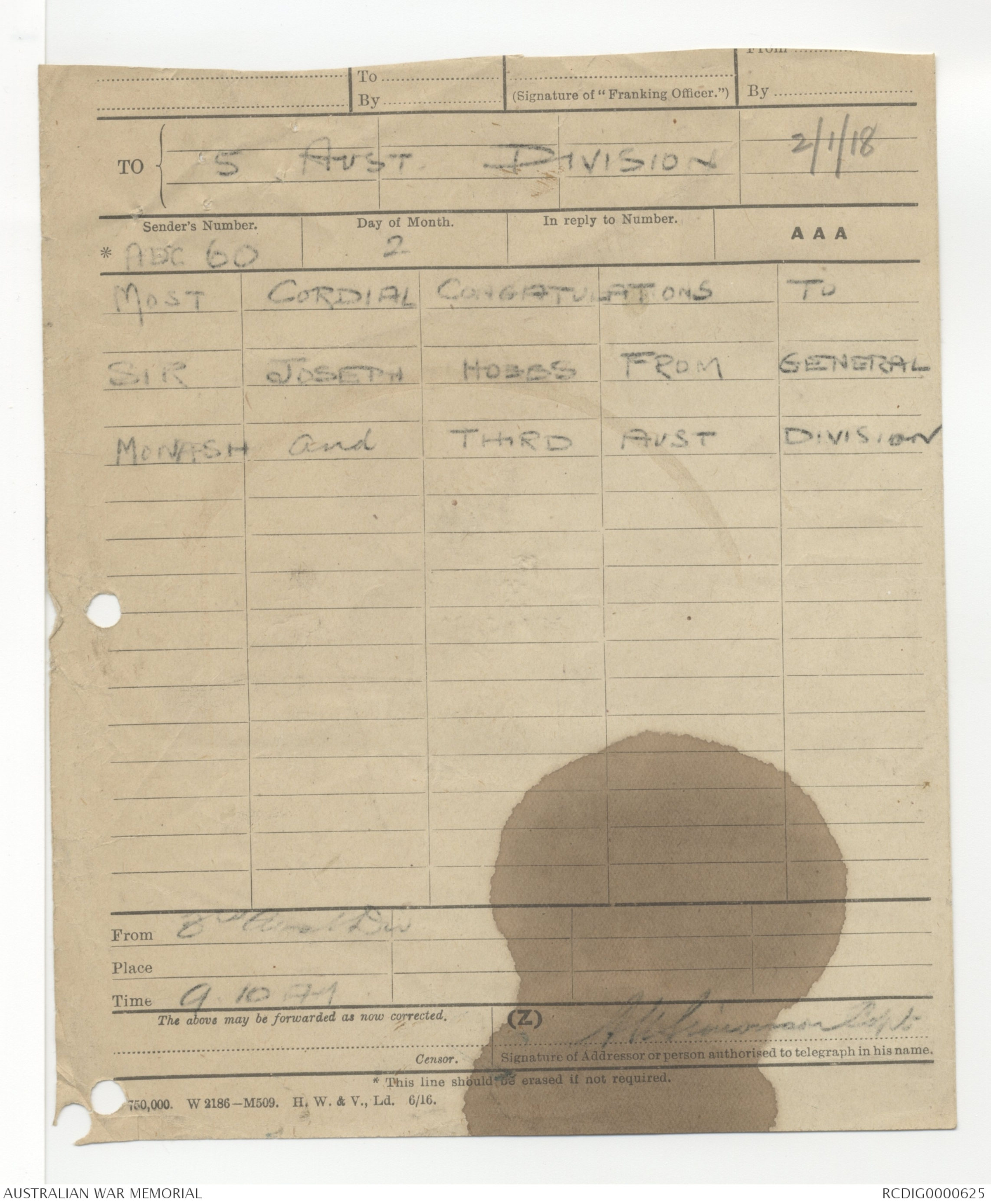
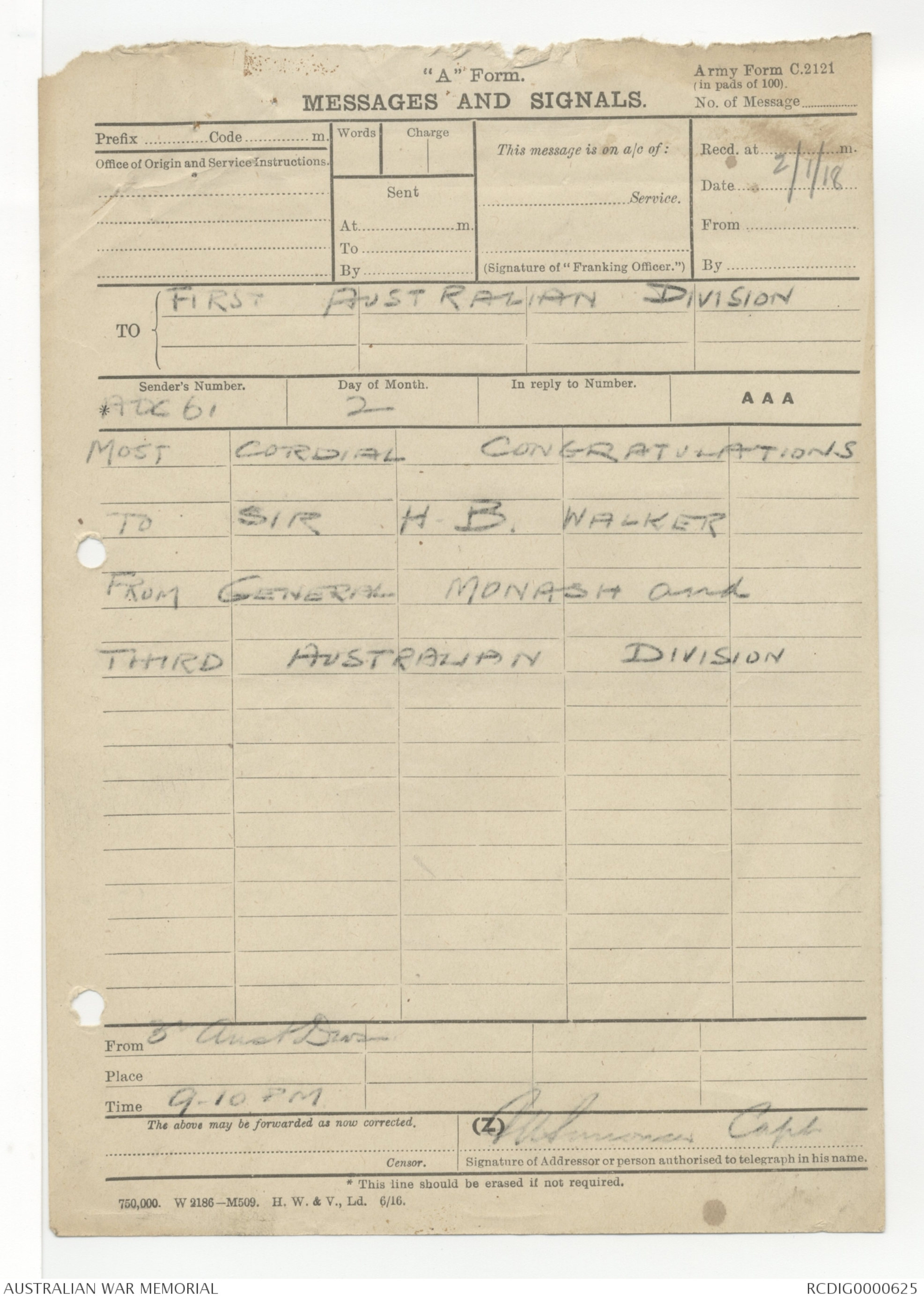
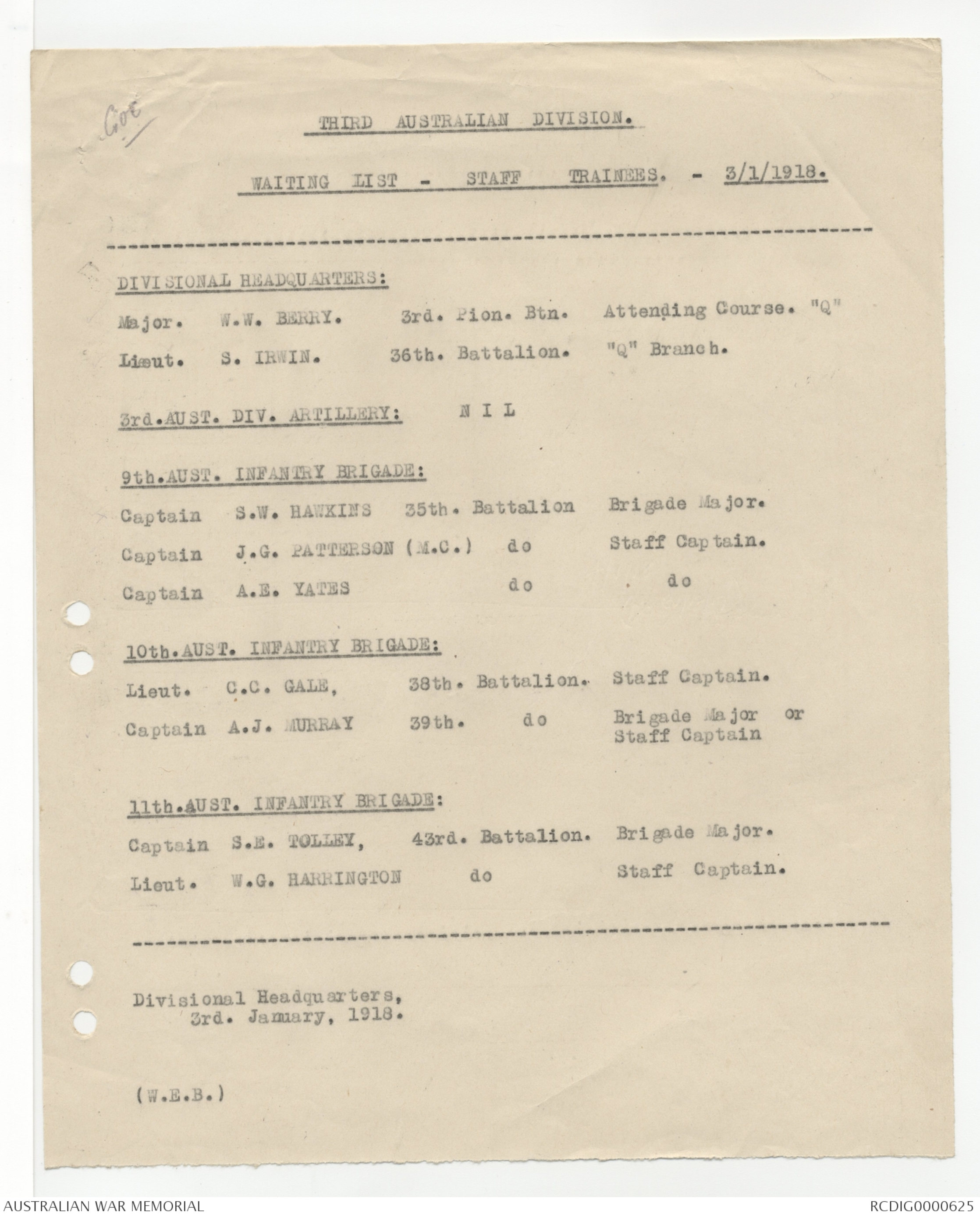
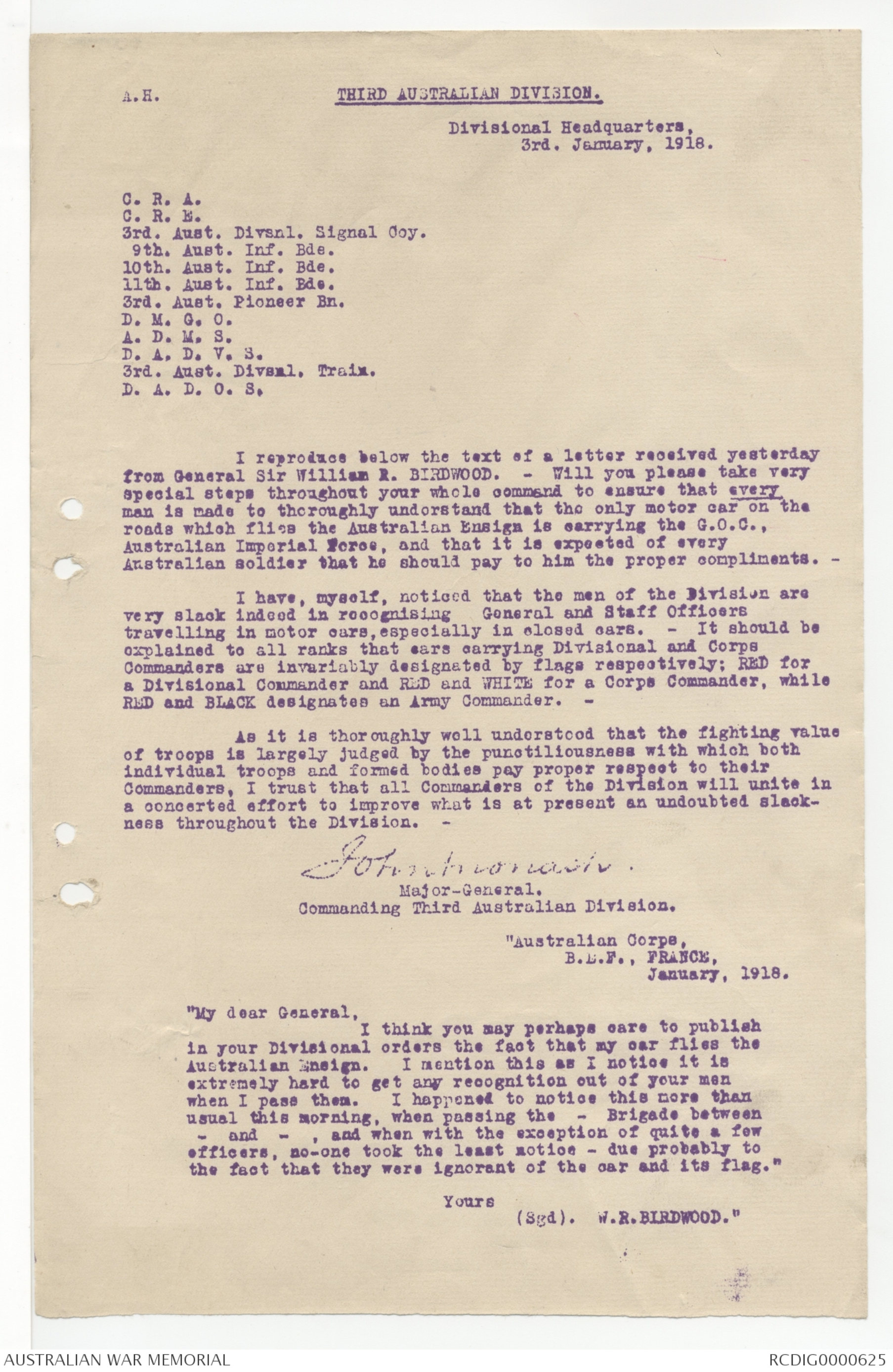
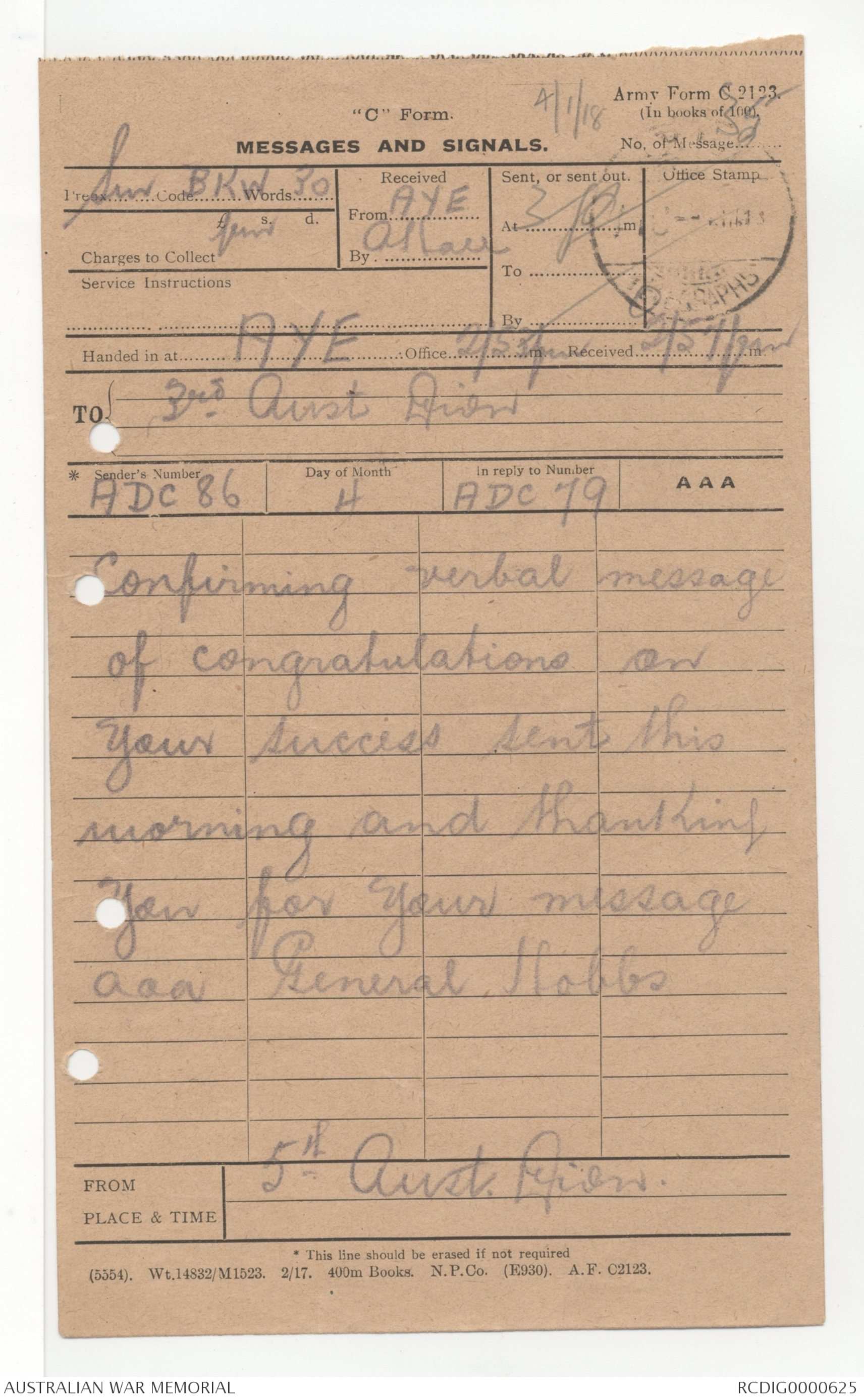

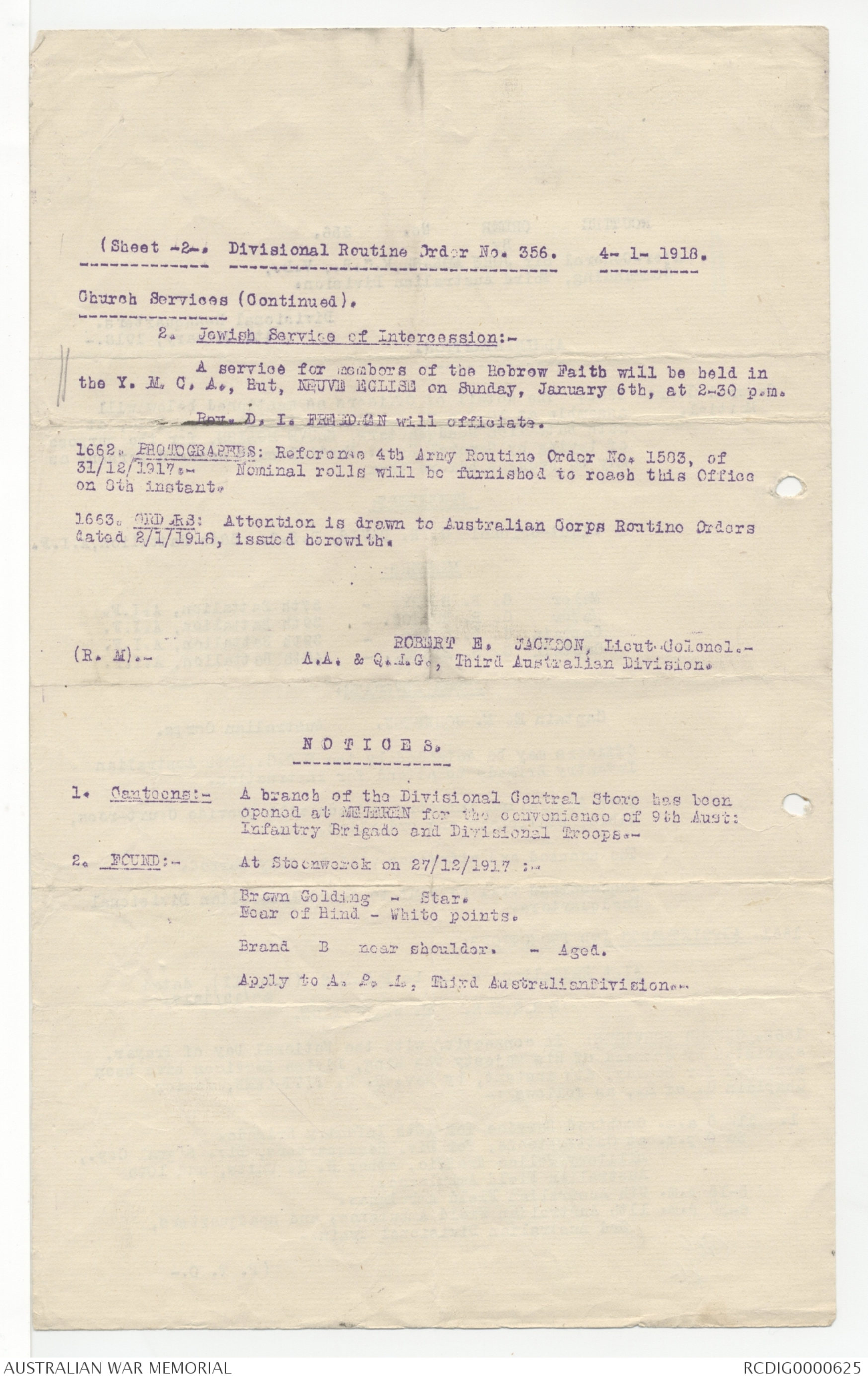
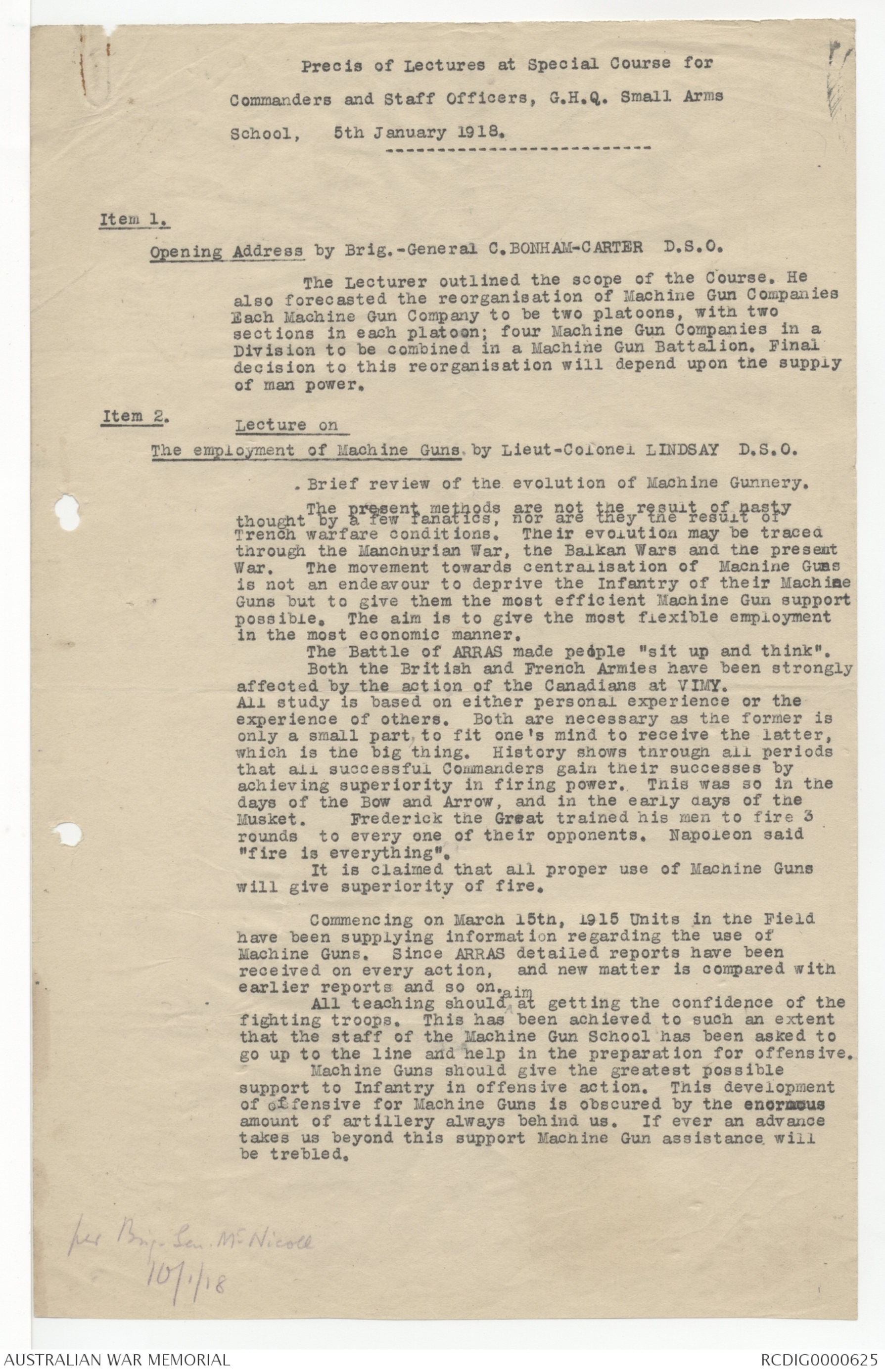
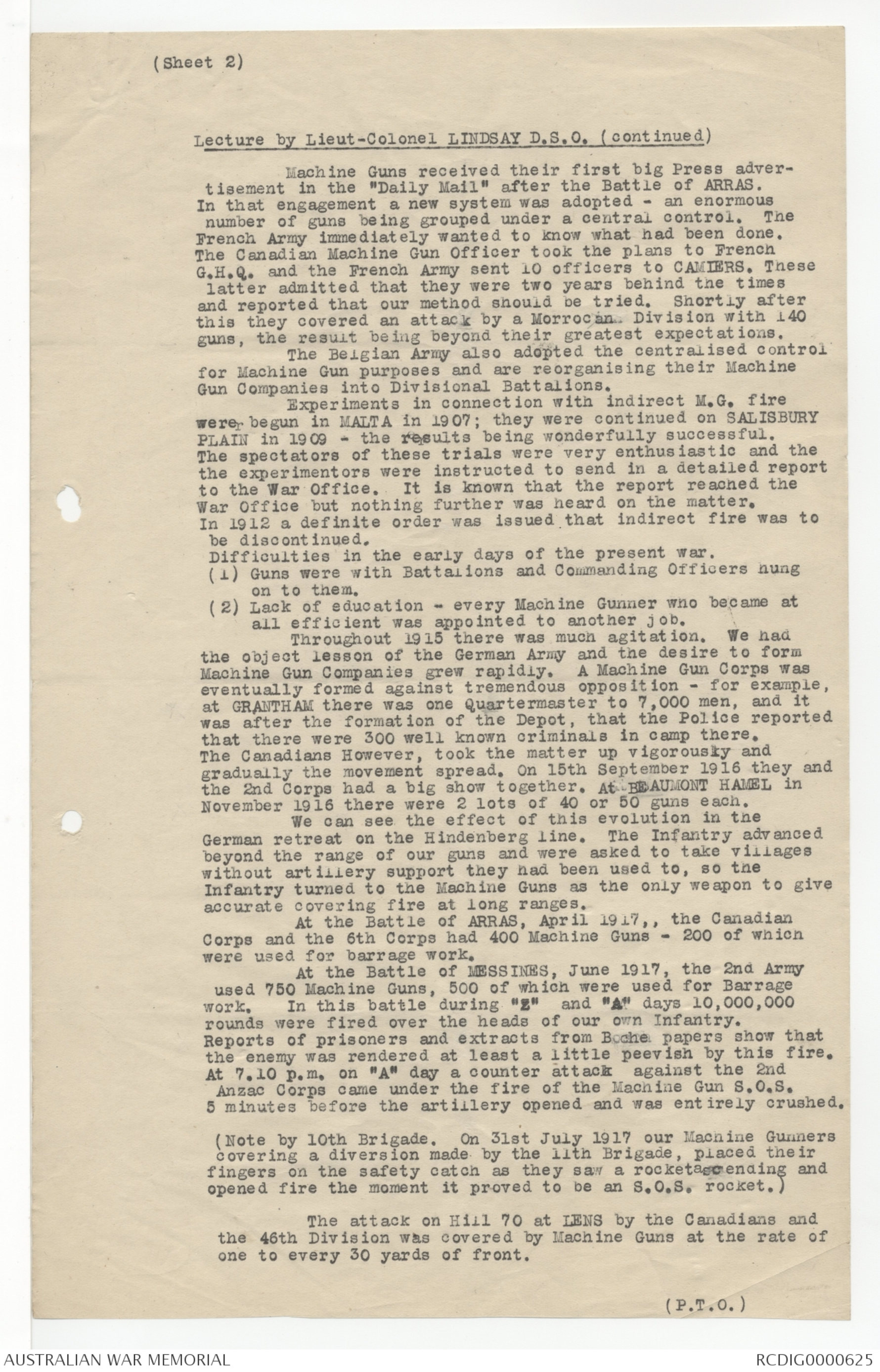
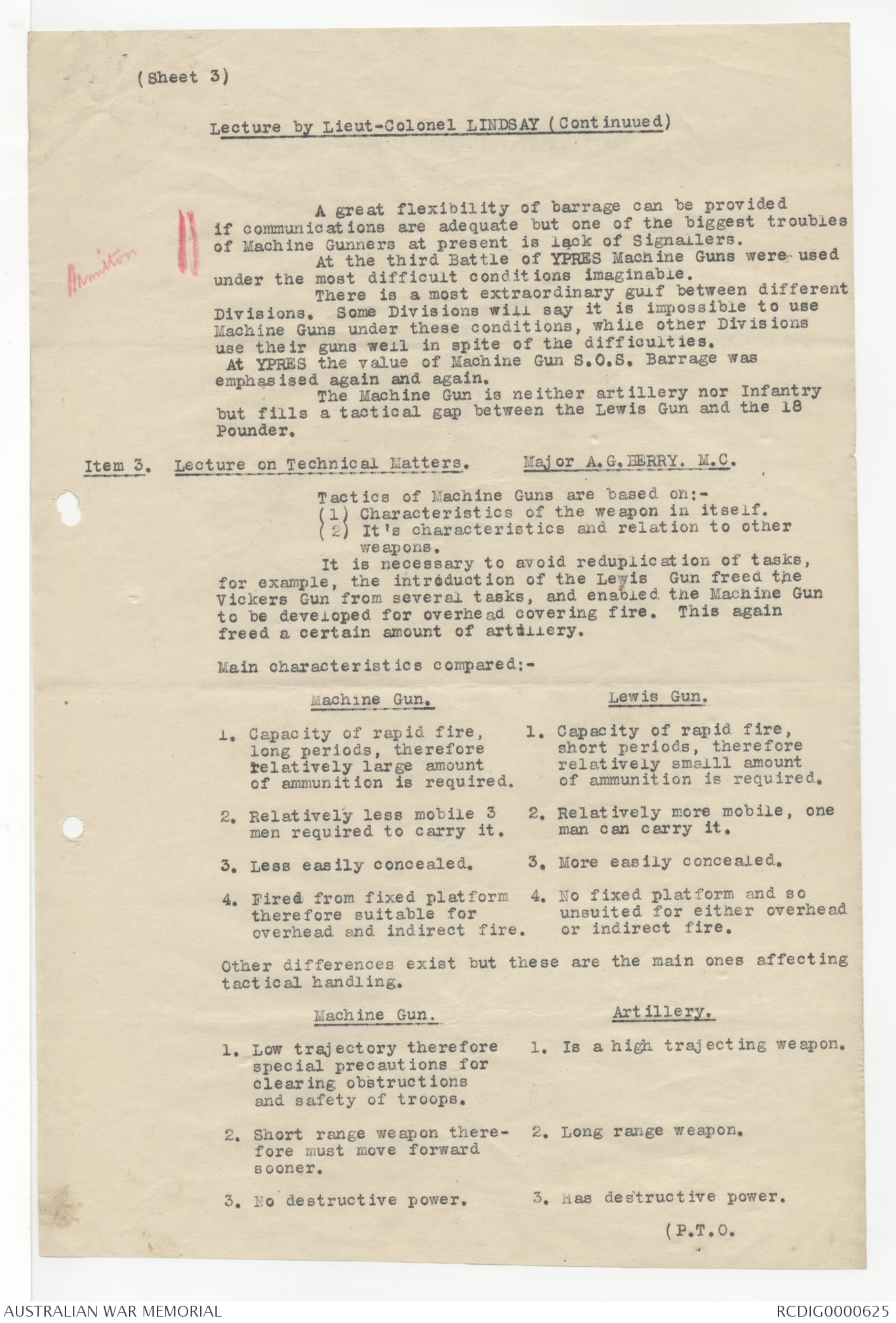
To.......
By...... (Signature of "Franking Officer.")
By.......
TO 5 AUST DIVISION 2/1/18
Sender's Number. Day of Month. In reply to Number. AAA
*ADC 60 2
MOST CORDIAL CONGRATULATIONS TO
SIR JOSEPH HOBBS FROM GENERAL
MONASH and THIRD AUST DIVISION
From 3rd Aust Div
Place
Time 9.10 AM
The above may now be forwarded as corrected.
(Z) A. M. Levinson Capt.
Signature of Addressor or person authorised to telegraph in his name.
'' A'' Form. Army Form C.2121
MESSAGES AND SIGNALS. No. of Message...
Prefix Code m.
Office of Origin and Service Instructions.
Words Charge
Sent
At.................. m.
To...................
By...................
This message is an a/c of:
.......................... Service.
............................................
(Signature of "Franking Officer.")
Recd. at ................... m.
Date 2/1/18
From..................................
By.............................
TO FIRST AUSTRALIAN DIVISION
Sender's Number. Day of Month. In reply to Number. AAA
*ADC 61 2
MOST CORDIAL CONGRATULATIONS
TO SIR H.B. WALKER
FROM GENERAL MONASH and
THIRD AUSTRALIAN DIVISION
From 3rd Aust Divn
Place
Time 9.10PM.
The above may be forwarded as now corrected.
(Z) A. M. Levinson Capt
Signature of Addressor or person authorized to telegraph in his name.
GOC
THIRD AUSTRALIAN DIVISION.
WAITING LIST - STAFF TRAINEES. - 3/1/1918.
DIVISIONAL HEADQUARTERS:
Major. W.W. BERRY. 3rd. Pion. Btn. Attending Course. "Q"
Lieut. S. IRWIN. 36th. Battalion. "Q" Branch.
3rd. AUST. DIV. ARTILLERY: N I L
9th. AUST. INFANTRY BRIGADE:
Captain S.W. HAWKINS 35th. Battalion Brigade Major.
Captain J.G. PATTERSON (M.C.) do Staff Captain.
Captain A.E. YATES do do
10th. AUST. INFANTRY BRIGADE:
Lieut. C.C. GALE, 38th. Battalion. Staff Captain.
Captain A.J. MURRAY 39th. do Brigade Major or
Staff Captain
11th.AUST. INFANTRY BRIGADE:
Captain S.E. TOLLEY, 43rd. Battalion. Brigade Major.
Lieut. W.G. HARRINGTON do Staff Captain.
-----------------------------------------
Divisional Headquarters,
3rd. January, 1918.
(W.E.B.)
A.E. THIRD AUSTRALIAN DIVISION.
Divisional Headquarters
3rd. January, 1918.
C. R. A.
C. R. E.
3rd. Aust. Divsnl. Signal Coy.
9th. Aust. Inf. Bde.
10th. Aust. Inf. Bde.
11th. Aust. Inf. Bde
3rd. Aust. Pioneer Bn.
D. M. G. O.
A. D. M. S.
D. A. D. V. S.
3rd. Aust. Divsnl. Train.
D. A. D. O. S.
I reproduce below the text of a letter received yesterday
from General Sir Willian R. BIRDWOOD. - Will you please take very
special steps throughout your whole command to ensure that every
man is made to thoroughly understand that the only motor car on the
roads which flies the Australian Ensign is carrying the G.O.C.,
Australian Imperial Force, and that it is expected of every
Australian soldier that he should pay to him the proper compliments.
I have, myself, noticed that the men of the Division are
very slack indeed in recognising General and Staff Officers
travelling in motor cars, especially in closed cars. - It should be
explained to all ranks that cars carrying Divisional and Corps
Commanders are invariably designated by flags respectively; RED for
a Divisional Commander and RED and WHITE for a Corps Commander, while
RED and BLACK designates an Army Commander. -
As it is thoroughly well understood that the fighting value
of troops is largely judged by the punctiliousness with which both
individual troops and formed bodies pay proper respect to their
Commanders, I trust that all Commanders of the Division will unite in
a concerted effort to improve what is at present an undoubted slackness
throughout the Division. -
John Monash
Major-General.
Commanding Third Australian Division.
"Australian Corps
B.E.F., FRANCE,
January, 1918.
"My dear General,
I think you may perhaps care to publish
in your Divisional orders the fact that my car flies the
Australian Ensign. I mention this as I notice it is
extremely hard to get any recognition out of your men
when I pass them. I happened to notice this more than
usual this morning, when passing the - Brigade between
- and - , and when with the exception of quite a few
officers, no-one took the least notice - due probably to
the fact that they were ignorant of the car and its flag."
Yours
(Sgd). W.R. BIRDWOOD."
4/1/18
Army Form C.2123.
"C" Form
MESSAGES AND SIGNALS. No. of Message...
Prefix Sm Code BKW Words 30
£ s. d.
Charges to collect
Service Instructions
Received
From AYE
By A Shall
Sent, or sent out.
At e pm
To...................
By..................
Office Stamp
ARMY
1918
TELEGRAPHS
Handed in at AYE Office 2/53 pm Received 2/57 pm
TO 3rd Aust Divn
Sender's Number ADC 86
Day of Month 4
In reply to Number
ADC 79
AAA
Confirming verbal message
of congratulations on
your success sent this
morning and thanking
you for your message
aaa General Hobbs
FROM 5th Aust. Divn.
PLACE & TIME
ROUTINE ORDER No. 356.
By
Major-General Sir JOHN MONASH, K.C.B., V.D.,
Commanding, Third Australian Division.
Divisional Headquarters.
4th January, 1918.-
ADMINISTRATION
General Court
Matial. - 1660. The detail of Officers as mentioned below will
assemble at 10-0 a.m. on Sunday, 6th January, 1915, at
39th Battalion Headquarters, NEUVE EGLISE, for the purpose
of trying by General Court-Martial such accused persons as
may be brought before them
PRESIDENT:
Lieut-Colonel C. H. DAVIS, D.S.O. 38th Battalion,A.I.F.
MEMBERS:
Major C. B. STORY - 37th Battalion, A.I.F.
Major C. R. HUTTON. - 39th Battalion, A.I.F.
Captain C. L. GILES. - 39th Battalion, A.I.F.
Captain G. S. BISDEE. - 40th Battalion, A.I.F.
JUDGE ADVOCATE:
Captain E. M. JOHNSTON. Australian Corps.
Officers may be detailed by the G.O.C., 40th Australian
Infantry Brigade to attend for instruction.
10th Australian Infantry Brigade will provide Court-room,
Bible, stationery and orderlies.
The accused and witnesses will be duly warned.
Proceedings will be sent to Third Australian Divisional
Headquarters.
1661. APOINTMENTS AND PROMOTIONS:
4lst Battalion: - To be B.Q.M.S. (W.O. II), dated
30/12/1917.
T/R.Q.M.S. H. W. SCHMIDT.
1662. CHURCH SERVICES: In connection with the National Day of Prayer,
appointed by Command of His Majesty The King, Divine Services have been
arranged for Sunday, 6th instant, by Rev. R. H. PITT-OWEN, Senior
Chaplain C. of E., as follows :-
1. 11- 0 a.m. Combined Service for 10th Infantry Brigade.
3 0 p.m. at Outtersteone, for Div. Headquarters, Div. Signal Coy.,
Military Police Traffic, other H. Q. Units, and 10th
Australian Field Ambulance.
5-15 p.m. 9th Australian Field Ambulance.
6-30 p.m. 11th Australian Field Ambulance, and Headquarters,
3rd Australian Divisional Train.-
(*GOC
AQ*)
(P. T. O.-
(Sheet -2-. Divisional Routine Order No. 356. 4- 1- 1918.
Church Services (Continued).
2. Jewish Service of Intercession:-
A service for members of the Hebrew Faith will be held in
the Y. M. C. A., Hut, NEUVE EGLISE on Sunday, January 6th,
at 2-30 p.m.
Rev D. I. FREEDMAN will officiate.
1662. PHOTOGRAPHES: Reference 4th Army Routine Order No. 1503, of
31/12/1917.- Nominal rolls will be furnished to reach this Office
on 8th instant.
1663. ORDERS: Attention is drawn to Australian Corps Routine Orders
dated 2/1/1918, issued herewith.
ROBERT E. JACKSON Lieut-Colonel.-
(R. M).- A.A. & Q.M.G., Third Australian Division.
N O T I C ES.
1. Canteens:- A branch of the Divisional Central Store has been
opened at METHREN for the convenience of 9th Aust:
Infantry Brigade and Divisional Troops.-
2. FOUND:- At Steenwerek on 27/12/1917 :-
Brown Golding - Star.
[[Near?]] of Hind - White points.
Brand B near shoulder. - Aged.
Apply to A. P. M., Third Australian Division.-
Precis of Lectures at Special Course for
Commanders and Staff Officers, G.H.Q. Small Arms
School, 5th January 1918.
-----
Item 1.
Opening Address by Brig.-General C.BONHAM-CARTER D.S.O.
The Lecturer outlined the scope of the Course. He
also forecasted the reorganisation of Machine Gun Companies
Each Machine Gun Company to be two platoons, with two
sections in each platoon; four Machine Gun Companies in a
Division to be combined in a Machine Gun Battalion. Final
decision to this reorganisation will depend upon the supply
of man power.
Item 2.
Lecture on
The employment of Machine Guns. by Lieut-Colonel LINDSAY D.S.O.
Brief review of the evolution of Machine Gunnery.
The present methods are not the result of nasty
thought by a few fanatics, nor are they the result of
Trench warfare conditions. Their evolution may be traced
through the Manchurian War, the Balkan Wars and the present
War. The movement towards centralisation of Machine Guns
is not an endeavour to deprive the Infantry of their Machine
Guns but to give them the most efficient Machine Gun support
possible. The aim is to give the most flexible employment
in the most economic manner.
The Battle of ARRAS made people "sit up and think".
Both the British and French Armies have been strongly
affected by the action of the Canadians at VIMY.
All study is based on either personal experience or the
experience of others. Both are necessary as the former is
only a small part, to fit one's mind to receive the latter,
which is the big thing. History shows through all periods
that all successful Commanders gain their successes by
achieving superiority in firing power. This was so in the
days of the Bow and Arrow, and in the early days of the
Musket. Frederick the Great trained his men to fire 3
rounds to every one of their opponents. Napoleon said
"fire is everything".
It is claimed that all proper use of Machine Guns
will give superiority of fire.
Commencing on March 15th, 1916 Units in the Field
have been supplying information regarding the use of
Machine Guns. Since ARRAS detailed reports have been
received on every action, and new matter is compared with
earlier reports and so on.
All teaching should, ∧ aim at getting the confidence of the
fighting troops. This has been achieved to such an extent
that the staff of the Machine Gun School has been asked to
go up to the line and help in the preparation for offensive.
Machine Guns should give the greatest possible
support to Infantry in offensive action. This development
of offensive for Machine Guns is obscured by the enormous
amount of artillery always behind us. If ever an advance
takes us beyond this support Machine Gun assistance will
be trebled.
(*per Brig. Gen. Mc Nicoll
10/1/18*)
(Sheet 2)
Lecture by Lieut-Colonel LINDSAY D.S.O. (continued)
Machine Guns received their first big Press advertisement
in the "Daily Mail" after the Battle of ARRAS.
In that engagement a new system was adopted - an enormous
number of guns being grouped under a central control. The
French Army immediately wanted to know what had been done.
The Canadian Machine Gun Officer took the plans to French
G.H.Q. and the French Army sent 10 officers to CAMIERS. These
latter admitted that they were two years behind the times
and reported that our method should be tried. Shortly after
this they covered an attack by a Morrocan- Division with 140
guns, the result being beyond their greatest expectations.
The Belgian Army also adopted the centralised control
for Machine Gun purposes and are reorganising their Machine
Gun Companies into Divisional Battalions.
Experiments in connection with indirect M.G. fire
were begun in MALTA in 1907; they were continued on SALISBURY
PLAIN in 1909 - the results being wonderfully successful.
The spectators of these trials were very enthusiastic and the
the experimentors were instructed to send in a detailed report
to the War Office. It is known that the report reached the
War Office but nothing further was heard on the matter.
In 1912 a definite order was issued that indirect fire was to
be discontinued.
Difficulties in the early days of the present war.
(1) Guns were with Battalions and Commanding Officers hung
on to them.
(2) Lack of education - every Machine Gunner who became at
all efficient was appointed to another job.
Throughout 1915 there was much agitation. We had
the object lesson of the German Army and the desire to form
Machine Gun Companies grew rapidly. A Machine Gun Corps was
eventually formed against tremendous opposition - for example,
at GRANTHAM there was one Quartermaster to 7,000 men, and it
was after the formation of the Depot, that the Police reported
that there were 300 well known criminals in camp there,
The Canadians However, took the matter up vigorously and
gradually the movement spread. On 15th September 1916 they and
the 2nd Corps had a big show together. At BEAUMONT HAMEL in
November 1916 there were 2 lots of 40 or 50 guns each.
We can see the effect of this evolution in the
German retreat on the Hindenberg line. The Infantry advanced
beyond the range of our guns and were asked to take villages
without artillery support they had been used to, so the
Infantry turned to the Machine Guns as the only weapon to give
accurate covering fire at long ranges.
At the Battle of ARRAS, April 1917,, the Canadian
Corps and the 6th Corps had 400 Machine Guns - 200 of which
were used for barrage work.
At the Battle of MESSINES, June 1917, the 2nd Army
used 750 Machine Guns, 500 of which were used for Barrage
work. In this battle during "Z" and "A" days 10,000,000
rounds were fired over the heads of our own Infantry.
Reports of prisoners and extracts from Boche papers show that
the enemy was rendered at least a little peevish by this fire.
At 7.10 p.m. on "A" day a counter attack against the 2nd
Anzac Corps came under the fire of the Machine Gun S.O.S.
5 minutes before the artillery opened and was entirely crushed.
(Note by 10th Brigade. On 31st July 1917 our Machine Gunners
covering a diversion made by the 11th Brigade, placed their
fingers on the safety catch as they saw a rocket ascending and
opened fire the moment it proved to be an S.O.S. rocket.)
The attack on Hill 70 at LENS by the Canadians and
the 46th Division was covered by Machine Guns at the rate of
one to every 30 yards of front.
(P.T.O.)
(Sheet 3)
Lecture by Lieut-Colonel LINDSAY (Continuued)
A great flexibility of barrage can be provided
if communications are adequate but one of the biggest troubles
of Machine Gunners at present is lack of Signallers. X Hamilton
At the third Battle of YPRES Machine Guns were used
under the most difficult conditions imaginable.
There is a most extraordinary gulf between different
Divisions. Some Divisions will say it is impossible to use
Machine Guns under these conditions, while other Divisions
use their guns well in spite of the difficulties.
At YPRES the value of Machine Gun S.O.S. Barrage was
emphasised again and again.
The Machine Gun is neither artillery nor Infantry
but fills a tactical gap between the Lewis Gun and the 18
Pounder.
Item 3. Lecture on Technical Matters. Major A.G.BERRY. M.C.
Tactics of Machine Guns are based on:-
(1) Characteristics of the weapon in itself.
(2) It's characteristics and relation to other
weapons.
It is necessary to avoid reduplication of tasks,
for example, the introduction of the Lewis Gun freed the
Vickers Gun from several tasks, and enabled the Machine Gun
to be developed for overhead covering fire. This again
freed a certain amount of artillery.
Main characteristics compared:-
| Machine Gun. | Lewis Gun. |
|
1. Capacity of rapid fire, short periods, therefore relatively smalll amount of ammunition is required. |
| 2. Relatively less mobile 3 men required to carry it. |
2. Relatively more mobile, one man can carry it. |
| 3. Less easily concealed. | 3. More easily concealed. |
| 4. Fired from fixed platform therefore suitable for overhead and indirect fire. |
4. No fixed platform and so unsuited for either overhead or indirect fire. |
| Other differences exist but these are the main ones affecting tactical handling. |
|
| Machine Gun. | Artillery. |
| 1. Low trajectory therefore special precautions for clearing obstructions and safety of troops. |
1. Is a high trajecting weapon. |
| 2. Short range weapon therefore must move forward sooner. |
2. Long range weapon |
| 3. No destructive power. | 3. Has destructive power. |
(P.T.0.
 Sam scott
Sam scottThis transcription item is now locked to you for editing. To release the lock either Save your changes or Cancel.
This lock will be automatically released after 60 minutes of inactivity.